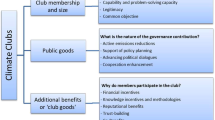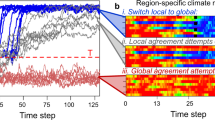Abstract
Although addressing climate change will ultimately require global cooperation, substantial progress may be achieved through small clubs of countries, where it is easier to forge and implement deals needed for policy coordination. Here we quantify the gains from cooperation in the Arctic region and find that nearly 90% of the potential for abating black carbon can be reached by countries acting in self-interest alone because soot, the main source of black carbon, causes severe harm to human health along with warming. Abating methane, by contrast, requires more cooperation because impacts are more diffused geographically. Well-designed clubs with as few as four members can realize more than 80% of the full group cooperation potential for reducing these pollutants. The pivotal player in every effective club is Russia—most other members of the Arctic Council, the institution most focused on advancing the collective interests of the region, offer little leverage on the problems at hand.
This is a preview of subscription content, access via your institution
Access options
Access Nature and 54 other Nature Portfolio journals
Get Nature+, our best-value online-access subscription
$29.99 / 30 days
cancel any time
Subscribe to this journal
Receive 12 print issues and online access
$209.00 per year
only $17.42 per issue
Buy this article
- Purchase on Springer Link
- Instant access to full article PDF
Prices may be subject to local taxes which are calculated during checkout




Similar content being viewed by others
References
Protection of Global Climate for Present and Future Generations of Mankind A/RES/43/53 (UN, 1988).
Bodansky, D. The United Nations Framework Convention on Climate Change: a commentary. Yale J. Int. Law 18, 451–558 (1993).
Victor, D. G. Global Warming Gridlock. Creating More Effective Strategies for Protecting the Planet. (Cambridge Univ. Press, Cambridge, 2011).
Stavins, R. et al. in Climate Change 2014: Mitigation of Climate Change (eds Edenhofer, O. et al.) Ch. 13 (Cambridge Univ. Press, Cambridge, 2014).
Almer, C. & Winkler, R. Analyzing the effectiveness of international environmental policies: The case of the Kyoto Protocol. J. Environ. Econ. Manage. 82, 125–151 (2017).
IPCC: Summary for Policymakers. In Climate Change 2014: Mitigation of Climate Change. (eds Edenhofer, O. et al.) (Cambridge Univ. Press, Cambridge, 2014).
Peters, G. P. et al. Key indicators to track current progress and future ambition of the Paris Agreement. Nat. Clim. Change 7, 118–122 (2017).
Keohane, R. O. & Victor, D. G. Cooperation and discord in global climate policy. Nat. Clim. Change 6, 570–575 (2016).
Barrett, S. Environment and Statecraft: The Strategy of Environmental Treaty-Making (Oxford Univ. Press, Oxford, 2003).
Carraro, C. & Siniscalco, D. Strategies for the international protection of the environment. J. Public Econ. 52, 309–328 (1993).
Brewer, T. L. Arctic Black Carbon from Shipping: A Club Approach to Climate-and-Trade Governance (International Centre for Trade and Sustainable Development, Geneva, 2015).
Ostrom, E. Governing the Commons: The Evolution of Institutions for Collective Action (Political Economy of Institutions and Decisions) (Cambridge Univ. Press, Cambridge, 1990).
Olson, M. The Logic of Collective Action. Public Goods and the Theory of Groups (Harvard Univ. Press, Cambridge, 1965).
Stigler, G. The theory of economic regulation. Bell J. Econ. 2, 3–21 (1971).
Falkner, R. A minilateral solution for global climate change? On bargaining efficiency, club benefits, and international legitimacy. Perspect. Polit. 14, 87–101 (2016).
Kahler, M. Multilateralism with small and large numbers. Int. Organ. 46, 681–708 (1992).
Hovi, J., Sprinz, D., Sælen, H. & Underdal, A. Climate clubs: A gateway to effective climate cooperation? Br. J. Polit. Sci. https://doi.org/10.1017/S0007123416000788 (2017).
Keohane, N., Petsonk, A. & Hanafi, A. Toward a club of carbon markets. Clim. Change 144, 81–95 (2017).
Brewer, T. L., Derwent, H. & Błachowicz, A. Carbon Market Clubs and the New Paris Regime: Paper for the World Bank Group’s Networked Carbon Markets Initiative (World Bank, Washington DC, 2016).
Abbott, K. W. The transnational regime complex for climate change. Environ. Plann. C 30, 571–90 (2012).
US-China Energy Collaboration (United States Department of Energy, 2017); https://energy.gov/ia/initiatives/us-china-clean-energy-research-center-cerc.
Norway’s International Climate and Forest Initiative (Norwegian Ministry of Climate and Environment, 2017); https://www.regjeringen.no/en/topics/climate-and-environment/climate/climate-and-forest-initiative/id2000712/.
Johnson, N. The last holdout among big palm oil businesses joins no-deforestation pledge. Grist (5 Dec 2014); http://grist.org/food/the-last-holdout-among-big-palm-oil-producers-joins-no-deforestation-pledge/.
Hsu, A., Moffat, A. S., Weinfurter, A. J. & Schwartz, J. D. Towards a new climate diplomacy. Nat. Clim. Change 5, 501–503 (2015).
Climate Commitments of Subnational Actors and Business: A Quantitative Assessment of their Emission Reduction Impact Report No. DEW/1917/NA (UNEP, Nairobi, 2015).
Adoption of the Paris Agreement FCCC/CP/2015/10/Add.1 (UNFCCC 2016).
Nordhaus, W. Climate Clubs: Overcoming free-riding in international climate policy. Am. Econ. Rev. 105, 1339–1370 (2015).
Hafner-Burton, E. M., Victor, D. G. & Lupu, Y. Political science research on international law: the state of the field. Am. J. Int. Law 106, 47–97 (2012).
Dunoff, J. L. & Pollack, M. A. (eds). Interdisciplinary Perspectives on International Law and International Relations. The State of the Art. (Cambridge Univ. Press, Cambridge, 2012).
Morgenthau, H. J. Politics Among Nations. The Struggle for Power and Peace (Alfred A. Knopf, New York, NY, 1948).
Keohane, R. O. After Hegemony: Cooperation and Discord in the World Political Economy (Princeton Univ. Press, Princeton, 1984).
Williamson, O. E. The Economic Institutions of Capitalism (Simon and Schuster, New York, NY, 1985).
Skjærseth, J. B. North Sea Cooperation: Linking International and Domestic Pollution Control (Manchester Univ. Press, Manchester, 2000).
Parson, E. A. Protecting the Ozone Layer: Science and Strategy (Oxford Univ. Press, Oxford, 2003).
AMAP Assessment 2015: Black Carbon and Ozone as Arctic Climate Forcers (AMAP, Oslo, 2015).
Shindell, D. et al. Simultaneously mitigating near-term climate change and improving human health and food security. Science 335, 183–189 (2012).
Wallack, J. S. & Ramanathan, V. The other climate changers. Why black carbon and ozone also matter. Foreign Aff. 88, 105–113 (2009).
Remarks at the Climate and Clean Air Coalition To Reduce Short-Lived Climate Pollutants Initiative: Remarks by Secretary of State Clinton (US Department of State, Washington DC, 2012); https://2009-2017.state.gov/secretary/20092013clinton/rm/2012/02/184061.htm.
Burney, J. A., Kennel, C. F. & Victor, D. G. Getting serious about the new realities of global climate change. Bull. Atom. Sci. 69, 49–57 (2013).
Ramanathan, V. & Xu, Y. The Copenhagen Accord for limiting global warming: criteria, constraints, and available avenues. Proc. Natl Acad. Sci. USA 107, 8055–8062 (2010).
Shoemaker, J. K., Schrag, D. P., Molina, M. J. & Ramanathan, V. What role for short-lived climate pollutants in mitigation policy? Science 342, 1323–1324 (2013).
United States Environmental Protection Agency (US EPA). Global Mitigation of Non-CO2 Greenhouse Gases: 2010-2030. EPA-430-R-13-011 (US EPA, Washington DC, 2013).
Near-Term Climate Protection and Clean Air Benefits: Actions for Controlling Short-Lived Climate Forcers (UNEP, Nairobi, 2011).
Wigley, T. M. L., Richels, R. & Edmonds, J. A. Economic and environmental choices in the stabilization of atmospheric CO2 concentrations. Nature 379, 240–243 (1996).
Levy, M. A. in Institutions for the Earth: Sources of Effective International Environmental Protection (eds Haas, P. M, Keohane, R. O. & Levy, M. A.) (MIT Press, Cambridge, MA, 1993).
Edenhofer, O. et al. Closing the emission price gap. Glob. Environ. Change 31, 132–143 (2015).
Milner, H. Interests, Institutions, and Information Domestic Politics and International Relations (Princeton Univ. Press, Princeton, NJ, 1997).
Castro, P., Hörnlein, L. & Michaelowa, K. Constructed peer groups and path dependence in international organizations: The case of the international climate change negotiations. Glob. Environ. Change 25, 109–120 (2014).
Raustiala, K. & Slaughter, A. M. in Handbook of International Relations (eds Carlsnaes, W., Risse, T. & Simmons, B.) Ch. 28 (Sage, London, 2002).
International Political Economy: Perspectives on Global Power and Wealth (eds Frieden, J. A. et al.) (W.W. Norton, New York, NY, 2010).
Huijnen, V. et al. The global chemistry transport model TM5: description and evaluation of the tropospheric chemistry version 3.0. Geosci. Model Dev. 3, 445–473 (2010).
Krol, M. et al. The two-way nested global chemistry-transport zoom model TM5: algorithm and applications. Atmos. Chem. Phys. 5, 417–432 (2005).
Burnett, R. T. et al. An integrated risk function for estimating the global burden of disease attributable to ambient fine particulate matter exposure. Environ. Health Perspect. 122, 397–403 (2014).
Jerrett, M. et al. Long-term ozone exposure and mortality. N. Engl. J. Med. 360, 1085–1095 (2009).
Lim, S. S. et al. A comparative risk assessment of burden of disease and injury attributable to 67 risk factors and risk factor clusters in 21 regions, 1990–2010: a systematic analysis for the Global Burden of Disease Study 2010. The Lancet 380, 2224–2260 (2012).
Global Energy Assessment — Toward a Sustainable Future (Cambridge Univ. Press, Cambridge, International Institute for Applied Systems Analysis, Laxenburg, 2012).
Department of Economic and Social Affairs, Population Division World Population Prospects: The 2008 Revision, Highlights Working Paper No. ESA/P/WP.210 (United Nations, New York, 2009).
Forouzanfar, M. H. et al. Global, regional, and national comparative risk assessment of 79 behavioural, environmental and occupational, and metabolic risks or clusters of risks in 188 countries, 1990–2013: a systematic analysis for the Global Burden of Disease Study 2013. Lancet 386, 2287–2323 (2015).
Malley, C. S. et al. Updated global estimates of respiratory mortality in adults ≥30 years of age attributable to long-term ozone exposure. Environ. Health Perspect. https://doi.org/10.1289/EHP1390 (2017).
Turner, M. C. et al. Long-term ozone exposure and mortality in a large prospective study. Am. J. Respir. Crit. Care Med. 193, 1134–1142 (2016).
Evans, J. et al. Estimates of global mortality attributable to particulate air pollution using satellite imagery. Environ. Res. 120, 33–42 (2013).
Silva, R. A., Adelman, Z., Fry, M. M. & West, J. J. The impact of individual anthropogenic emissions sectors on the global burden of human mortality due to ambient air pollution. Environ. Health Perspect. 124, 1776–1784 (2016).
Krewski, D. et al. Extended follow-up and spatial analysis of the American Cancer Society study linking particulate air pollution and mortality. Res. Rep. Health Eff. Inst. 140, 5–114 (2009).
Anenberg, S. C., Horowitz, L. W., Tong, D. Q. & West, J. J. An estimate of the gobal burden of anthropogenic ozone and fine particulate matter on premature human mortality using atmospheric modeling. Environ. Health Perspect. 118, 1189–1195 (2010).
Wang, X. & Mauzerall, D. L. Characterizing distributions of surface ozone and its impact on grain production in China, Japan and South Korea: 1990 and 2020. Atmos. Environ 38, 4383–4402 (2004).
Adams, R. M., Glyer, J. D., Johnson, S. L. & McCarl, B. A. A reassessment of the economic effects of ozone on U.S. agriculture. JAPCA 39, 960–968 (1989).
Van Dingenen, R. et al. The global impact of ozone on agricultural crop yields under current and future air quality legislation. Atmos. Environ. 43, 604–618 (2009).
Global Agro-Ecological Zones V3.0 (IIASA and FAO, 2012, accessed 11 November 2016); http://www.gaez.iiasa.ac.at/.
Lesser, V. M., Rawlings, J. O., Spruill, S. E. & Sommerville, M. C. Ozone effects on agricultural crops: 15 statistical methodologies and estimated dose-response relationships. Crop Sci. 30, 148–155 (1990).
Myhre, G. et al. in Climate Change 2013: The Physical Science Basis (eds Stocker, T. F. et al.) Ch. 8 (IPCC, Cambridge Univ. Press, Cambridge, 2013).
Mortality Risk Valuation in Environment, Health and Transport Policies Ch. 7 (OECD, Paris, 2012).
Main Economic Indicators — Complete Database (OECD, accessed 8 February 2017); http://dx.doi.org/10.1787/data-00052-en.
The Benefits and Costs of the Clean Air Act 1990 to 2010 EPA-410-R-99-001 (US EPA, Washington DC, 1999).
Gross Domestic Product: Implicit Price Deflator, retrieved Federal Reserve Bank of St. Louis (Unites States Bureau of Economic Analysis, accessed 7 February 2017); https://fred.stlouisfed.org/series/GDPDEF.
Klimont, Z. et al. Modeling Particulate Emissions in Europe: A Framework to Estimate Reduction Potential and Control Costs IIASA Interim Report IR-02-076 (IIASA, Laxenburg, 2002).
Acknowledgements
We thank R. Andrew for creating Fig. 2, and T. Brånå for research assistance. The study was funded by the Research Council of Norway, project no. 235548. We thank R. O. Keohane, J. Hovi, M. Amann, J. S. Fuglestvedt and A. Underdal for valuable comments, along with participants in seminars at University of Pennsylvania, Georgetown, CICERO and project meetings of the SLCF project.
Author information
Authors and Affiliations
Contributions
S.A., S.K. and D.G.V. conceived the study. R.V.D. computed the impact of targeted emission reductions on pollutant concentrations and exposure. S.A. monetized the impacts and collected the cost estimates. S.A., S.K. and D.G.V. performed the club analyses. S.A., S.K. and D.G.V. wrote the manuscript, with contributions from all authors.
Corresponding author
Ethics declarations
Competing interests
The authors declare no competing financial interests.
Additional information
Publisher’s note: Springer Nature remains neutral with regard to jurisdictional claims in published maps and institutional affiliations.
Supplementary information
Supplementary Information
Supplementary Methods, Supplementary Tables 1–13, Supplementary Figures 1–10 and Supplementary References.
Rights and permissions
About this article
Cite this article
Aakre, S., Kallbekken, S., Van Dingenen, R. et al. Incentives for small clubs of Arctic countries to limit black carbon and methane emissions. Nature Clim Change 8, 85–90 (2018). https://doi.org/10.1038/s41558-017-0030-8
Received:
Accepted:
Published:
Issue Date:
DOI: https://doi.org/10.1038/s41558-017-0030-8
This article is cited by
-
Marginal Damage of Methane Emissions: Ozone Impacts on Agriculture
Environmental and Resource Economics (2023)
-
The downstream air pollution impacts of the transition from coal to natural gas in the United States
Nature Sustainability (2020)
-
Coalition-structured governance improves cooperation to provide public goods
Scientific Reports (2020)



